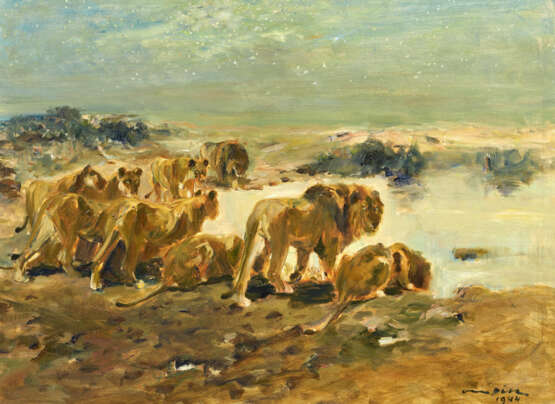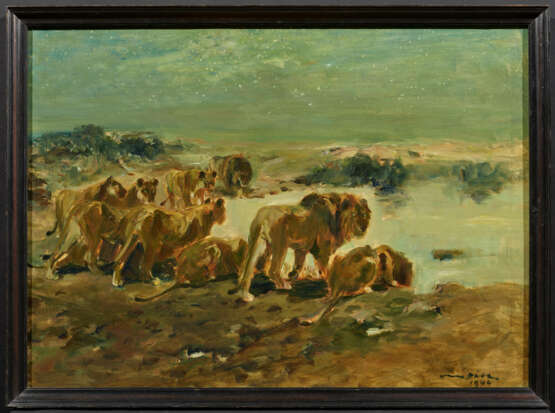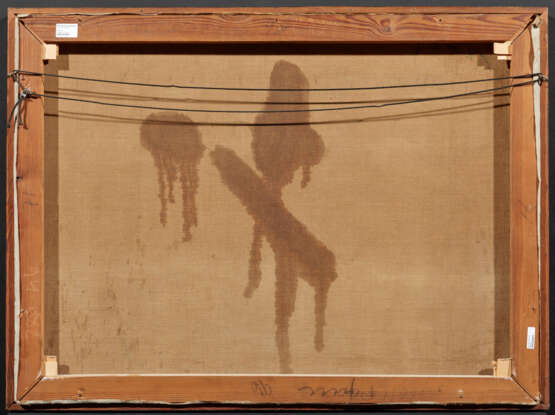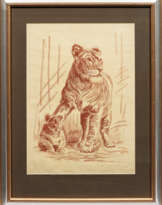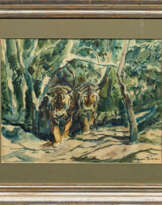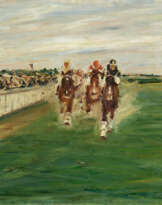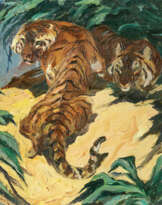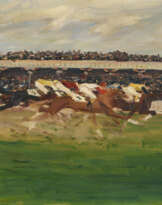ID 1319961
Lot 1394 | Otto Dill. Lion Pride at the Water at Night
Estimate value
€ 8 000 – 15 000
1884 Neustadt - 1957 Bad Dürkheim
Title:
Lion Pride at the Water at Night.
Date:
1944.
Technique:
Oil on canvas.
Measurement:
72 x 96.5cm.
Notation:
Signed and dated lower right: "Otto Dill 1944".
Frame:
Framed.
Provenance:
Private ownership, Germany.
Otto Dill comes from a simple, poor background. He is the second eldest of five sons of a civil servant in the postal service and is only six years old when his father dies. The art and animal-loving boy was therefore not destined for a great career. The young Otto Dill started his professional life in 1901 with a commercial apprenticeship in a print shop. Here he was also able to utilise his talent as a self-taught draughtsman. In 1908, Dill began studying under the animal painter Heinrich von Zügel in Munich. He initially received financial support from a patron, later he was awarded a scholarship and was also able to earn extra money through occasional graphic art. His breakthrough came as early as 1912: Otto Dill sold a lion painting from an exhibition at the Munich Secession and was awarded the large gold medal by the Munich Academy in the same year. This was the start of a career as a freelance artist, which only really took off after the First World War. Unlike his teacher Heinrich von Zügel, Otto Dill painted fewer farm animals; the dynamics and movement of sport horses was one of his major themes. From an early age, Dill was also fascinated by lions and cats of prey, which he first observed and studied in zoological gardens and then, on later journeys, in the wild. This specialisation also earned the painter the nickname 'Lion Dill'. The public and the art trade are enthusiastic about Otto Dill's special way of depicting animals. He captures the speed and energy of the creatures with impressionistic, quick strokes. His works sell well, he becomes a professor and receives public honours. Otto Dill travelled extensively through southern Europe and North Africa and painted prolifically. In 1930, he moved from Munich back to his hometown of Neustadt i.d. Pfalz, and eleven years later to Bad Dürkheim, where he died at the age of 73.
Catalogue 1395, an early work from 1918, shows two tigers in the bushes, a motif that Dill similarly encountered in this phase of his work with lions or black panthers. The moving, lancet-shaped leaves, the extreme perspective on the back of one of the cats of prey with its patterned fur, but also the heavily impasto brushstroke make this painting appear very intense and close to Expressionism.
The undated catalogue 1396 also has two cats of prey as its subject. However, they are depicted as a relaxed, resting pair. The surroundings have been withdrawn, the interaction with grooming and the comforting posture of the outstretched lion with its left leg slightly raised is the subject of this painting.
The pack of lions at the watering hole (catalogue 1394) from 1944 has a completely different effect: the harmony of the big cats living in freedom with their surroundings, the special lighting mood of the bright starry sky and the water surface, but also the almost demonic brightness of the lions' eyes lend the painting a special atmosphere.
Catalogue 1398 shows two racehorses being brought to the lead ring by their grooms after being saddled. An audience behind a fence watches the energetic bodies of the four-legged athletes. Judging by the fashion, the undated painting could date from the 1940s.
Judging by the fashion, they date from the 1930s.
The harmonious team of four horses (catalogue 1399) pulling a closed carriage are also sport horses. The painting was created in 1931 when the car had replaced the carriage as a means of transport; however, such teams can still be admired in equestrian sport today.
Otto Dill was born exactly 140 years ago and it is a nice coincidence to be able to offer five of his typical paintings from different phases of his work here.
| Artist: | Otto Dill (1884 - 1957) |
|---|---|
| Applied technique: | Oil |
| Auction house category: | Paintings by newer masters |
| Artist: | Otto Dill (1884 - 1957) |
|---|---|
| Applied technique: | Oil |
| Auction house category: | Paintings by newer masters |
| Address of auction |
VAN HAM Kunstauktionen GmbH Hitzelerstr. 2 50968 Köln Germany | ||||||||||||||
|---|---|---|---|---|---|---|---|---|---|---|---|---|---|---|---|
| Preview | |||||||||||||||
| Phone | +49 221 92586215 | ||||||||||||||
| Fax | +49 221 92 58 62 4 | ||||||||||||||
| Buyer Premium | 32% | ||||||||||||||
| Conditions of purchase | Conditions of purchase | ||||||||||||||
| Business hours | Business hours
|
